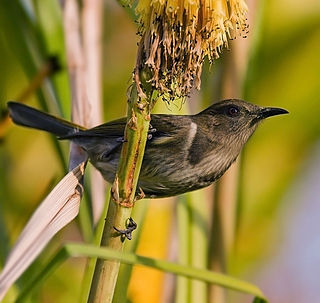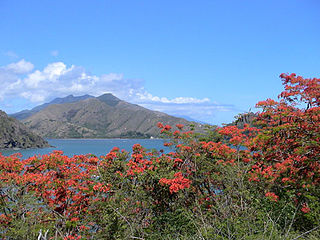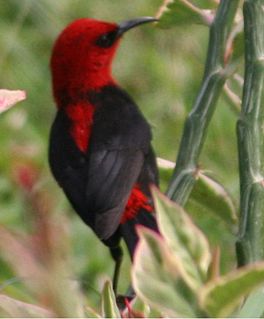
The honeyeaters are a large and diverse family, Meliphagidae, of small to medium-sized birds. The family includes the Australian chats, myzomelas, friarbirds, wattlebirds, miners and melidectes. They are most common in Australia and New Guinea, and found also in New Zealand, the Pacific islands as far east as Samoa and Tonga, and the islands to the north and west of New Guinea known as Wallacea. Bali, on the other side of the Wallace Line, has a single species.

The dusky myzomela or dusky honeyeater is a small, brown bird that is a common resident of the Aru Islands, southern New Guinea and northern and eastern Australia, where there are two separated populations, one in the Top End, another from Cape York Peninsula along the east coast as far south as the New South Wales border, though the species is rare south of Rockhampton. The Moluccan myzomela, red-tinged myzomela, and Biak myzomela were formerly considered conspecific, but was split as distinct species by the IOC in 2021.

The scarlet myzomela or scarlet honeyeater is a small passerine bird of the honeyeater family Meliphagidae native to Australia. It was first described by English ornithologist John Latham in 1801. At 9 to 11 centimetres long, it is the smallest honeyeater in Australia. It has a short tail and relatively long down-curved bill. It is sexually dimorphic; the male is a striking bright red with black wings, while the female is entirely brown. The species is more vocal than most honeyeaters, and a variety of calls have been recorded, including a bell-like tinkling.

Mont Panié is a mountain on the island of Grande Terre in New Caledonia, a special collectivity of France located in the south-west Pacific Ocean. At 1,628 metres (5,341 ft), it is the island's highest point. Mont Panié is situated in the Chaîne Centrale mountain range. The second highest peak on the island, Mount Humboldt, is nearly as tall as Mont Panié, with an elevation of 1,618 metres (5,308 ft).

The black honeyeater is a species of bird in the honeyeater family Meliphagidae. The black honeyeater exhibits sexual dimorphism, with the male being black and white while the female is a speckled grey-brown; immature birds look like the female. The species is endemic to Australia, and ranges widely across the arid areas of the continent, through open woodland and shrubland, particularly in areas where the emu bush and related species occur.

Myzomela is a genus of bird in the honeyeater family Meliphagidae. It is the largest genus of honeyeaters, with 39 species, and the most geographically widespread. It ranges from Indonesia to Australia and into the islands of the Pacific Ocean as far as Micronesia and Samoa.

The New Caledonian myzomela is a species of bird in the honeyeater family Meliphagidae. The species is sometimes considered to be conspecific with the scarlet myzomela of Australia.

The cardinal myzomela is a species of bird in the honeyeater family Meliphagidae. It is named for the scarlet color of the male. It is found in American Samoa, New Caledonia, Samoa, Solomon Islands, and Vanuatu, as well as some islands in Micronesia such as Yap. Its natural habitats are subtropical or tropical moist lowland forest and subtropical or tropical mangrove forest. It frequents areas with flowers, such as gardens. This is a small, active bird, measuring about 13 cm (5.1 in) from bill to tail. Males are red and black in coloration, females are grayish-olive, sometimes with a red cap or red head. Its long, curved bill is especially adapted for reaching into flowers for nectar. Cardinal myzomela populations have vanished from the island of Guam since the invasion of the brown tree snake.

The red-headed myzomela or red-headed honeyeater is a passerine bird of the honeyeater family Meliphagidae found in Australia, Indonesia, and Papua New Guinea. It was described by John Gould in 1840. Two subspecies are recognised, with the nominate race M. e. erythrocephala distributed around the tropical coastline of Australia, and M. e. infuscata in New Guinea. Though widely distributed, it is not abundant within this range. While the IUCN lists the Australian population of M. e. infuscata as being near threatened, as a whole the widespread range means that its conservation is of least concern.

Iriana is the First Lady of Indonesia since 20 October 2014 and the wife of the current President of Indonesia, Joko Widodo.
The Alor myzomela is a species of bird in the family Meliphagidae, the honeyeaters. It is endemic to the Indonesian island of Alor, where it is the only representative member of the genus Myzomela. It is named after Dewi Malia Prawiradilaga, an ornithologist at the Indonesian Institute of Science and one of the first leading female Indonesian ornithologists.
The Taliabu myzomela is a species of bird in the honeyeater family. It was first described in 2020. The species was named after the village of Wahe on Taliabu Island, which is the gateway to the highest elevations on Taliabu where it most commonly occurs.










